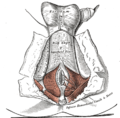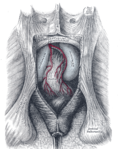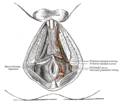Ischioanal fossa
Ischioanal Fossa
The Ischioanal Fossa, also known as the Ischiorectal Fossa, is an important anatomical space located in the pelvis. It is a fat-filled space that lies on each side of the anal canal and below the pelvis diaphragm. The ischioanal fossa plays a crucial role in providing room for the expansion of the anal canal during defecation, as well as housing various blood vessels, nerves, and fat.
Anatomy[edit]
The ischioanal fossa is pyramid-shaped with its base facing the skin around the anus and its apex pointing towards the origin of the levator ani muscle. The fossa is bordered medially by the external anal sphincter and the levator ani muscle, laterally by the ischium bone and the obturator internus muscle, anteriorly by the perineal body, and posteriorly by the sacrotuberous ligament and the gluteus maximus muscle.
Contents[edit]
The ischioanal fossa contains:
- Fat: The primary content, which serves as a cushion and provides flexibility.
- Pudendal nerve: This nerve runs through the fossa, providing sensory and motor innervation to the pelvic region.
- Blood vessels: Including branches of the internal pudendal artery and vein.
- Lymphatics: Lymph vessels and nodes involved in the drainage of the pelvis and perineum.
Clinical Significance[edit]
The ischioanal fossa is of particular interest in medicine due to its involvement in various conditions:
- Abscesses: Infections can lead to the formation of an abscess in the ischioanal fossa, which may require surgical drainage.
- Anesthesia: The pudendal nerve can be blocked in this region to provide anesthesia for childbirth and some surgical procedures.
- Injuries: Trauma to the pelvis can involve the ischioanal fossa, affecting the structures contained within it.
Surgical Considerations[edit]
Knowledge of the ischioanal fossa's anatomy is essential for surgeries involving the rectum, anus, and perineum. Procedures such as the excision of rectal tumors, repair of anal fistulas, and the drainage of abscesses necessitate careful navigation of this space to avoid damage to the pudendal nerve and other vital structures.
See Also[edit]
-
Ischioanal fossa
-
Ischioanal fossa
-
Ischioanal fossa
-
Ischioanal fossa
Ad. Transform your life with W8MD's Budget GLP-1 injections from $75


W8MD offers a medical weight loss program to lose weight in Philadelphia. Our physician-supervised medical weight loss provides:
- Weight loss injections in NYC (generic and brand names):
- Zepbound / Mounjaro, Wegovy / Ozempic, Saxenda
- Most insurances accepted or discounted self-pay rates. We will obtain insurance prior authorizations if needed.
- Generic GLP1 weight loss injections from $75 for the starting dose.
- Also offer prescription weight loss medications including Phentermine, Qsymia, Diethylpropion, Contrave etc.
NYC weight loss doctor appointmentsNYC weight loss doctor appointments
Start your NYC weight loss journey today at our NYC medical weight loss and Philadelphia medical weight loss clinics.
- Call 718-946-5500 to lose weight in NYC or for medical weight loss in Philadelphia 215-676-2334.
- Tags:NYC medical weight loss, Philadelphia lose weight Zepbound NYC, Budget GLP1 weight loss injections, Wegovy Philadelphia, Wegovy NYC, Philadelphia medical weight loss, Brookly weight loss and Wegovy NYC
|
WikiMD's Wellness Encyclopedia |
| Let Food Be Thy Medicine Medicine Thy Food - Hippocrates |
Medical Disclaimer: WikiMD is not a substitute for professional medical advice. The information on WikiMD is provided as an information resource only, may be incorrect, outdated or misleading, and is not to be used or relied on for any diagnostic or treatment purposes. Please consult your health care provider before making any healthcare decisions or for guidance about a specific medical condition. WikiMD expressly disclaims responsibility, and shall have no liability, for any damages, loss, injury, or liability whatsoever suffered as a result of your reliance on the information contained in this site. By visiting this site you agree to the foregoing terms and conditions, which may from time to time be changed or supplemented by WikiMD. If you do not agree to the foregoing terms and conditions, you should not enter or use this site. See full disclaimer.
Credits:Most images are courtesy of Wikimedia commons, and templates, categories Wikipedia, licensed under CC BY SA or similar.
Translate this page: - East Asian
中文,
日本,
한국어,
South Asian
हिन्दी,
தமிழ்,
తెలుగు,
Urdu,
ಕನ್ನಡ,
Southeast Asian
Indonesian,
Vietnamese,
Thai,
မြန်မာဘာသာ,
বাংলা
European
español,
Deutsch,
français,
Greek,
português do Brasil,
polski,
română,
русский,
Nederlands,
norsk,
svenska,
suomi,
Italian
Middle Eastern & African
عربى,
Turkish,
Persian,
Hebrew,
Afrikaans,
isiZulu,
Kiswahili,
Other
Bulgarian,
Hungarian,
Czech,
Swedish,
മലയാളം,
मराठी,
ਪੰਜਾਬੀ,
ગુજરાતી,
Portuguese,
Ukrainian




